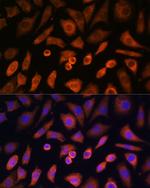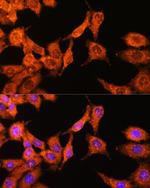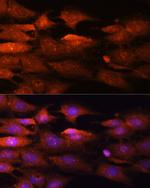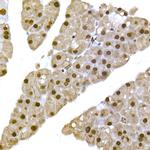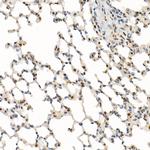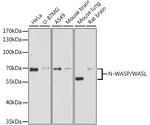Search Thermo Fisher Scientific
产品信息
PA5-96170
种属反应
宿主/亚型
分类
类型
抗原
偶联物
形式
浓度
纯化类型
保存液
内含物
保存条件
运输条件
RRID
产品详细信息
Immunogen sequence: MSSVQQQPPP PRRVTNVGSL LLTPQENESL FTFLGKKCVT MSSAVVQLYA ADRNCMWSKK CSGVACLVKD NPQRSYFLRI FDIKDGKLLW EQELYNNFVY NSPRGYFHTF AGDTCQVALN FANEEEAKKF RKAVTDLLGR RQRKSEKRRD PPNGPNLPMA TVDIKNPEIT TNRFYGPQVN NISHTKEKKK GKAKKKRLTK ADIGTPSNFQ HIGHVGWDPN TGFDLNNLDP ELKNLFDMCG ISEAQLKDRE; Positive Samples: HeLa, U-87MG, A-549, Mouse brain, Mouse lung, Rat brain; Cellular Location: Cytoplasm, Nucleus, cytoskeleton
靶标信息
The Wiskott-Aldrich syndrome (WAS) family of proteins share similar domain structure, and are involved in transduction of signals from receptors on the cell surface to the actin cytoskeleton. The presence of a number of different motifs suggests that they are regulated by a number of different stimuli, and interact with multiple proteins. Recent studies have demonstrated that these proteins, directly or indirectly, associate with the small GTPase, Cdc42, known to regulate formation of actin filaments, and the cytoskeletal organizing complex, Arp2/3. The WASL gene product is a homolog of WAS protein, however, unlike the latter, it is ubiquitously expressed and shows highest expression in neural tissues. It has been shown to bind Cdc42 directly, and induce formation of long actin microspikes.
⚠WARNING: This product can expose you to chemicals including mercury, which is known to the State of California to cause birth defects or other reproductive harm. For more information go to www.P65Warnings.ca.gov.
仅用于科研。不用于诊断过程。未经明确授权不得转售。
篇参考文献 (0)
生物信息学
蛋白别名: Actin nucleation-promoting factor WASL; DKFZp779G0847; MGC48327; n wasp; N-WASP; Neural Wiskott-Aldrich syndrome protein; Wiskott-Aldrich syndrome-like
基因别名: 2900021I12Rik; 3110031I02Rik; N-WASP; NWASP; TRS4; WASL; WASPB
UniProt ID: (Human) O00401, (Mouse) Q91YD9
Entrez Gene ID: (Human) 8976, (Mouse) 73178, (Rat) 682507


